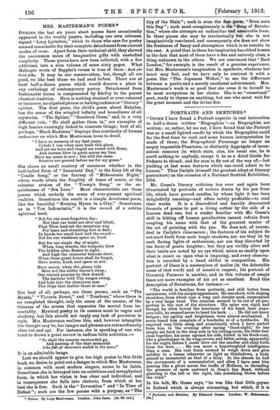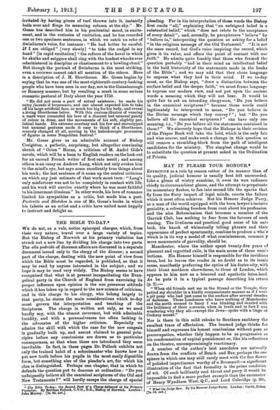PORTRAITS AND SKETCHES.* "OFTEN I have found a Portrait superior
in real instruction to half-a-dozen written ' Biographies '—as Biographies are written ; or, rather, let me say, I have found that the Portrait
was as a small lighted candle by which the Biographies could for the first time be read, and some human interpretation be made of them; the Biographical Personage no longer an empty impossible Phantasm, or distinctly Aggregate of incon- sistent rumours (in which state, alas, his usual one, he is worth nothing to anybody, except it be as a dried thistle for Pedants to thrash, and for men to fly out of the way of)—but
yielding at last some features which one could admit to be human." Thus Carlyle (himself the greatest adept at literary portraiture) on the occasion of a National Scottish Exhibition, 1854.
Mr. Gosse's literary criticism has ever and again been illuminated by portraits of writers drawn by his pen from life, which have proved candles, by whose light it has been delightfully amusing—and often subtly profitable—to read their works. It is a discredited and heavily discounted formula of praise to put a living author by the side of a
famous dead one, but a reader familiar with Mr. Gosse's skill in hitting off human peculiarities cannot refrain from coupling his name with that of the greatest master of the art of painting with the pen. He does not, of course,
deal in Carlyle's chiaroscuro ; the features of his subject do not start forth from such tragic shadows, nor are they lit by such flaring lights of enthusiasm, nor are they distorted by the force of poetic laughter ; but they are vividly alive and their traits are noted by an eye which seizes as readily upon what is comic as upon what is imposing, and every observa- tion is recorded by a hand skilful in composition. His portrait of Ibsen is a masterpiece of malice (in the delectable sense of that word) and of sensitive respect ; his portrait of Coventry Patmore is another, and in this volume of essays there are more examples of his art as excellent. Read this description of Swinburne, for instance :—
"The world is familiar from portraits, and still better from caricatures, with his unique appearance. He was short, with sloping shoulders, from which rose a long and slender neck, surmounted by a very large head. The cranium seemed to be out of all pro- portion to the rest of the structure. His spine was rigid, and though he often bowed the heaviness of his head, lasso papa- vera collo, he seemed never to bend his back.. . . He did not know fatigue ; his agility and brightness were almost mechanical. I never heard him complain of a headache or of a toothache. He required very little sleep, and occasionally when I have parted from him in the evening after saying 'Good-night,' he has simply sat back in the deep sofa in his sitting-room, his little feet close together, his arms against his side, folded in his frock-coat, like a grasshopper in its wing-covers, and fallen asleep, apparently for the night, before I could blow out the candles and steal forth from the door. . . . He was more a hypertrophied intelligence than a man. His vast brain seemed to weigh down and give solidity to a frame otherwise as light as thistledown, a body almost as immaterial as that of a fairy. In the streets he had the movements of a somnambulist, and often I have seen him passing like a ghost across the traffic of Holborn, or threading the pressure of carts eastward in Gray's Inn Road, without glancing to the left or the right, like something blown before the wind."
In his talk, Mr. Gosse says, " he was like that little geyser in Iceland which is always simmering, but which, if it is
• Portraits and Sketches. By Edmund Goose. London: W. Heinemann, Ps.]
irritated by having pieces of turf thrown into it, instantly boils over and flings its menacing column at the sky." Mr.
Gosse has described him in his penitential mood, in excite- ment, and in the ecstasies of recitation, and he has recorded one or two specimen sentences, in which we catch an echo of Swinburne's voice, for instance : " He had better be careful. If I am obliged". [very slowly] "to take the cudgel in my hand" [in rapid exultation] " the rafters of the hovel in which
be skulks and sniggers shall ring with the loudest whacks ever administered in discipline or chastisement to a howling churl." But though the portrait of Swinburne is the most striking, even a reviewer cannot omit all mention of the others. Here is a description of J. H. Shorthonse. Mr. Gosse begins by
• saying that he was one of the most eighteenth-century-looking people who have been seen in our day, not in the Gainsborough 'or Romney manner, but by recalling a mask in some serious romantic pastoral of Italy about the year 1750.
"He did not seem a part of actual existence; he made his .entryfacendo it bergamasco, and one almost expected him to take off his large artificial face, so much too big for his body, and reveal a living Shorthouse below. With this curious illusion of wearing a mask were connected his love of a discreet but unusual gaiety ,of colour in dress, and the movements of his soft, slightly pre- latical hands. His extreme courtesy and his few and stereotyped but unusual gestures made it easy to think of a Shorthouse, scarcely changed at all, moving in the kaleidoscopic procession of figures in some Neapolitan festival."
Mr. Gosse gives us an admirable account of Bishop Creighton, a pathetic, surprising, but altogether convincing sketch of " Orion " Horne, a criticism of M. Andre Gide's novels, which will be a boon to English readers on the look-out for an unread French writer of first-rate merit; and among others is an essay on Andrew Lang, which not only evokes him to the mind's eye, but says some excellently true things about his work; the last sentence of it sums up the central criticism on which any just estimate of that work must turn : "Lang's only misfortune was not to be completely in contact with life,
and his work will survive exactly where he was most faithful to his innermost illusions." In other words, his love of romance
limited his sympathies as a critic, but made him a poet. Portraits and Sketches is one of Mr. Gosse's books in which his talents as an artist and a critic have united most happily to instruct and delight us.











































 Previous page
Previous page